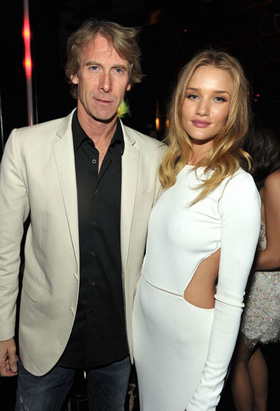 LOS ANGELES – America's first mission to the moon wasn't just about scientific advancement and national pride; it was about investigating the crash of a mysterious Cybertronian spaceship.
LOS ANGELES – America's first mission to the moon wasn't just about scientific advancement and national pride; it was about investigating the crash of a mysterious Cybertronian spaceship.
So begins "Transformers: Dark of the Moon," the third installment in the sci-fi franchise inspired by Hasbro's line of shape-shifting toys. Director Michael Bay showed about 15 minutes of assorted footage from his first 3-D film Wednesday at Paramount Studios as part of a discussion with filmmaker James Cameron about the challenges and benefits of 3-D moviemaking.
Though Bay was initially skeptical about the multidimensional medium ("It might be a gimmick," he said in 2009), he said he "ended up loving it."
"It was just great to sculpt with space," he said. "It just felt right for this movie."
Cameron helped convince his fellow filmmaker to embrace 3-D technology and employ it in the latest "Transformers" adventure, set for domestic release on July 1.
The film opens with a look at Cybertron and its spacecraft flying through a geometric landscape when one ship crash lands on Earth's moon. It's the 1960s, and President John F. Kennedy and broadcaster Walter Cronkite are talking about the U.S. mission to the moon. President Richard Nixon is shown praising astronauts "Neil and Buzz," who, after taking one giant step for mankind, explore the wreckage of the otherworldly ship.
The footage also shows star Shia LaBeouf and his beloved Camaro/robot buddy, Bumblebee. Another shot takes a long, lingering look at Rosie Huntington-Whiteley, the Victoria's Secret model who replaced Megan Fox as the film's female lead. In her first acting role, Huntington-Whiteley appears wide-eyed and slack-jawed, her bee-stung lips perfectly parted.
The clips also offered glimpses at some of the film's other stars, including John Turturro, Tyrese Gibson, Josh Duhamel, Frances McDormand and Ken Jeong of "The Hangover" fame, who is shown nervously wielding a pair of pistols.
The 3-D action scenes thrilled, though Bay said the special effects aren't finished yet. Flying robots battle military helicopters, which crash dramatically into the sea. There was a menacing multi-tentacled robot that appeared to have evil intentions, and a trio of Transformers scaling a skyscraper, eventually causing it to topple to the ground.
"I came up with that building sequence while I was doing stomach crunches," Bay said after the footage played. "That's the weirdest place I've ever come up with an action scene."
Doing "Transformers" in 3-D added about $30 million to the film's budget, Bay said, explaining that it blends film, digital and converted-to-3-D footage.
"I just watched the movie and couldn't tell the difference between digital and film," Cameron said. "This movie is a testament to the fact that it's indistinguishable to the eye."
The filmmakers agreed, however, that not all 3-D is good 3-D. Some films are converted too cheaply and quickly, they said, and moviegoers don't like the results.
"The 3-D gets people back into the cinema experience, the big screen and stuff that we love, but we're abusing it left and right," Cameron said. "Some studios are making poor decisions about which films to convert and how to convert."
But he and Bay are convinced that 3-D is here to stay and cameras and conversion methods will continue to improve.
"I had fun on the set shooting it," Bay said. "It was like a new toy."
The most exciting thing about 3-D? Audience reaction, Cameron said.
"When they see something that blows their minds, that's the most exciting part," he said. "You know you've won them. You know you've taken them someplace, like what we've just experienced here."
Copyright © 2011 The Associated Press. All rights reserved.
- Comment









